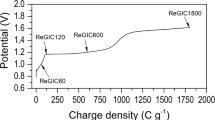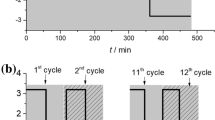Abstract
Exfoliated graphite (EG) was modified by a two-stage process consisting of electrochemical oxidation followed by the thermal treatment. Within the former one, the process of re-intercalation of H2SO4 into the EG by linear sweep voltammetry was carried out. Thus, obtained re-intercalated EG underwent heat treatment at 800 °C in order to synthesize re-exfoliated EG (re-EG). The electrochemical features of the re-EG were examined in the model process of phenol electrooxidation carried out by cyclic voltammetry technique in alkaline solution with and without phenol addition. Taking into account the anodic charges as a main criterion of electrochemical activity, it was found that the modification of EG caused over twofold improvement of its electrochemical activity. This behavior is related with the changes within the chemical composition of modified EG surface and on much smaller scale with the modification of its structure. The degree of electrochemical activity improvement depends on the conditions under which the processes of re-intercalation and re-exfoliation were performed. The results of Fourier-transform infrared spectroscopy (FTIR) and X-ray photoelectron spectroscopy (XPS) analysis supported by the data of the Brunauer-Emmett-Teller (BET) surface area and scanning electron microscope (SEM) observations allow an understanding of the physicochemical properties of re-exfoliated EG and enhancement of its electrochemical activity.











Similar content being viewed by others
References
Chung DDL (1987) J Mater Sci 22:4190
Lee JH, Shin DW, Makotchenko VG, Nazarov AS, Fedorov VE, Kim YH, Choi J, Kim JM, Yoo J (2009) Adv Mater 21:1
Bourelle E, Cloude-Montigny B, Metrot A (1998) Mol Cryst Liq Cryst 310:321
Yakovlev AY, Finaenov AI, Zabud’kov SL, Yakovleva EV (2006) Russ J Appl Chem 79:1741
Toyoda M, Inagaki M (2000) Carbon 38:199
Zheng W, Wong S (2003) Compos Sci Technol 63:225
Li W, Han C, Liu W, Zhang M, Tao K (2007) Catal Today 125:278
Bhattacharya A, Hazra A, Chatterjee S, Sen P, Laha S, Basumallick I (2004) J Power Sources 136:208
Mitra S, Sampath S Electrochem Solid-State Lett 7:A264
Lueking AD, Pan L, Narayanan DL (2005) J Phys Chem B 109:12710
Krawczyk P (2011) Chem Eng J 172:1096
Fukushima H, Drzal LT, Rook BP, Rich MJ (2006) J Therm Anal Calorim 85:235
Skowroński JM, Krawczyk P (2004) J Solid State Electrochem 8:442
Ramesh P, Sampath S (2001) Analyst 126:1872
Krawczyk P, Skowroński JM (2010) J Appl Electrochem 40:91
Dhakate SR, Chauhan N, Sharma S, Tawale J, Singh S, Sahare PD, Mathur RB (2011) Carbon 49:1946
Tanaike O, Yamada Y, Kodama M, Miyajima N (2012) J Phys Chem Solids 73:1420
Gottrell M, Kirk DW (1992) J Electrochem Soc 139:2736
Boudenne JL, Cerclier O, Galéa J, Bianco P (1998) J Electrochem Soc 145:2763
Martinez-Huitle CA, Ferro S (2006) Chem Soc Rev 35:1324
Skowroński JM, Krawczyk P (2007) J Solid State Electrochem 11:223
Świątkowski A, Pakuła M, Biniak S, Walczyk M (2004) Carbon 42:3057
Terzyk AP (2001) Colloids Surf A 177:23
László K, Tombácz E, Josepovits K (2001) Carbon 39:1217
Okpalugo TIT, Papakonstantinou P, Murphy H, McLaughlin J, Brown NMD (2005) Carbon 43:153
Acknowledgments
This work was financially supported by the grant of the Poznan University of Technology No. 03/31/DSPB/0292.
Author information
Authors and Affiliations
Corresponding author
Rights and permissions
About this article
Cite this article
Krawczyk, P., Gurzęda, B. Electrochemical properties of exfoliated graphite affected by its two-step modification. J Solid State Electrochem 20, 361–369 (2016). https://doi.org/10.1007/s10008-015-3051-0
Received:
Revised:
Accepted:
Published:
Issue Date:
DOI: https://doi.org/10.1007/s10008-015-3051-0




